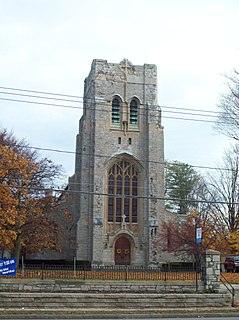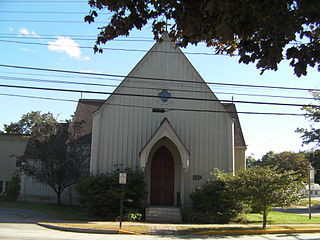
St. John's Episcopal Church is a historic Episcopal church located on the village green in the village of Highgate Falls in Highgate, Vermont, in the United States. Built 1829-30, it is prominent local example of a Federal style church with Gothic Revival features. On September 3, 1976, it was listed on the National Register of Historic Places.

The former Grace Episcopal Church is an historic Episcopal church located on U.S. Route 1 half a mile northwest of its junction with 3rd Street in Robbinston, Maine, in the United States. Built in 1882, it is one of a series of churches along Maine's coast that was funded by summer residents, and is a fine vernacular expression of Carpenter Gothic architecture. It was listed on the National Register of Historic Places in 2001. It is now the museum of the Robbinston Historical Society.

St. Luke's Episcopal Church is a historic church on United States Route 7 in Lanesborough, Massachusetts. It is an early example of a stone Gothic Revival church, and only one of two surviving 19th century Gothic Revival church buildings in Berkshire County. The church was listed on the National Register of Historic Places in 1972. It is today used primarily for occasional summer services.

Saint Paul's Church, Chapel, and Parish House are a historic Episcopal Church complex at 15 and 27 Saint Paul Street and 104 Aspinwall Avenue in Brookline, Massachusetts. The Gothic Revival church building was designed by Richard Upjohn and built in 1851-52, and is the oldest surviving religious building in the town. The complex was listed on the National Register of Historic Places in 1985.

St. James Episcopal Church is located on East Main Street in Batavia, New York, United States. It is a stone Neo-Gothic structure built in the early 20th century.

The West Scarborough United Methodist Church, also known as the Dunstan Methodist Episcopal Church, is a historic church on U.S. Route 1 in Scarborough, Maine. The church building, built in 1839 and extensively altered in 1907, is one of the few surviving works of Maine architect and artist Harry Hayman Cochrane. The building was listed on the National Register of Historic Places in 1989 for its architectural significance.

St. Paul's Church and Rectory is an historic Episcopal church at 279 Congress Street in Portland, Maine. Built in 1868 for a newly established congregation, it is a fine local example of Gothic Revival architecture, designed by English architect George Browne Pelham. It was listed on the National Register of Historic Places in 1978. The present pastor is Rev. Samuel L. Logan.

St. Paul's Episcopal Church is a historic church at 27 Pleasant Street in Brunswick, Maine. Built in 1845, it is a distinctive early example of a modest Carpenter Gothic design by Richard Upjohn, then already well known for his larger-scale Gothic churches. The building was listed on the National Register of Historic Places in 1978. The rector is Rev. Carolyn H. Eklund.

Christ Episcopal Church is a historic church located at 1 Dresden Avenue in Gardiner, Maine. Built in 1820 for the oldest congregation in the Episcopal Diocese of Maine. It is the oldest known example of ecclesiastical Gothic Revival architecture in New England, and was listed on the National Register of Historic Places in 1973.

The Old Pittston Congregational Church is a historic church building on Pittston School Road in Pittston, Maine. Built in 1836, it is an architecturally distinctive blend of Federal, Greek Revival, and Gothic Revival architecture, and was listed on the National Register of Historic Places in 1978. The congregation, organized in 1812 by Major Reuben Colburn, now meets at 21 Arnold Road. It is affiliated with the Conservative Congregational Christian Conference.

The South Parish Congregational Church and Parish House is a historic church at 9 Church Street in Augusta, Maine. Built in 1865, the church is a major Gothic Revival work of Maine's leading mid-19th century architect, Francis H. Fassett, and its 1889 parish house, designed by James H. Cochrane, is a rare example in the state of Stick style architecture. The property was listed on the National Register of Historic Places in 1980. The congregation was established in 1773, when the area was part of Hallowell.

St. Mary's Church is a Roman Catholic church at 41 Western Avenue in Augusta, Maine. Built in 1926, it is one of the city's finest examples of Gothic Revival architecture. It was listed on the National Register of Historic Places in 1987.

St. Andrew's Church is a historic Episcopal church at 11 Glidden Street in Newcastle, Maine. Built in 1883, it was the first example of cottage Gothic Revival church in the country, and the first US design of English architect Henry Vaughan, a major proponent of the style. It was listed on the National Register of Historic Places in 1976.

St. John's Episcopal Church is a historic church on the south side of Maine State Route 27 at Blinn Hill Road in Dresden Mills, Maine. Built in 1832, it is a distinctive architectural blend of Federal, Greek Revival and Gothic Revival styling. It was listed on the National Register of Historic Places in 1991.

The Union Church is a historic church on High Street, north of the center of Buckfield, Maine. Built in 1831-32, it is a well-proportioned Federal-style church with Gothic Revival alterations. It served for a time as Buckfield's town hall, and is now managed by the Town of Buckfield. It was listed on the National Register of Historic Places in 1980.

Winterport Congregational Church, originally and once again the Winterport Union Meeting House, is a historic church at 177 Main Street in Winterport, Maine. Built in 1831, it is a prominent little-altered example of Gothic Revival architecture, designed and built by Calvin Ryder, a well-known regional architect and builder. It was listed on the National Register of Historic Places in 1973.

First Presbyterian Church is a Presbyterian Church (USA) church located in Muscatine, Iowa, United States. It, along with the attached Sunday School building, were listed on the National Register of Historic Places in 1977.

St. Paul's Episcopal Church is a historic parish of the Episcopal Church in Watertown, Wisconsin,. Its buildings display different phases of Gothic Revival architecture, and in 1979 the complex was added to the National Register of Historic Places for its architectural significance.

The town hall of Winchester, New Hampshire, is located on Main Street, just south of the junction of New Hampshire Route 10 and New Hampshire Route 119 in the center of the town. Built of brick in 1911-12 to a design by S. Winthrop St. Clair, it is the only Gothic Revival town hall in Cheshire County. It was built because the previous town meeting house was destroyed by fire. The church was also designed by St. Clair, a Boston-based architect who hailed from Winchester.

St. James Episcopal Church is a congregation of the Episcopal Church located at Lake George in Warren County, New York. It is noted for its historic parish church, completed in 1867.






















